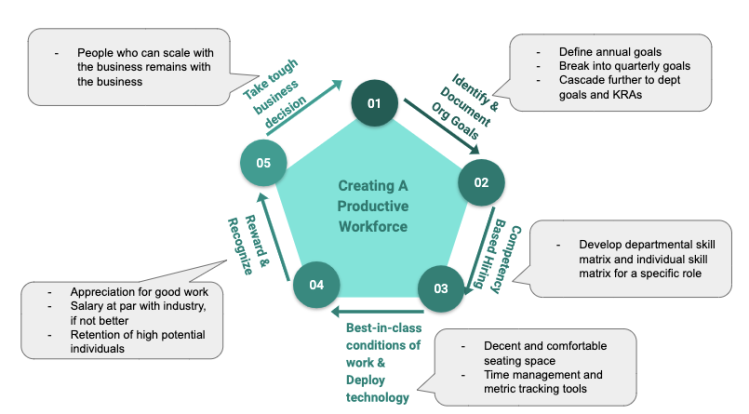“Creating A Productive Workforce”, an essence for every organization. Few key questions in this aspect are as below :
- How do we define a productive workforce?
- How do we create a productive workforce?
- Does creating a productive workforce a simple process involving few reports and MIS or it requires an overall culture change?
- How to draw a thin line from being informed as a leader and micro managing a team?
- Can productivity at work be driven and achieved only if it is linked with Performance Appraisals?
Let’s look at answering all these questions subsequently.
To any leader, a productive happy workforce defines the success of an organization. Creating a productive workforce is a practice and not just a process. All the processes of an organization needs to be aligned towards making an organization culture productive. The step by step approach towards creating a productive workforce is :

- Hiring the right talent : It’s all about getting the right talent onboard, someone who meets your business requirement not at present but someone who can can scale up as the business scales. An individual may not be productive right from Day 1 but he/she needs to demonstrate the attitude towards being a part of a culture thats survives on being productive
- Condition of work : A productive ambience encourages productive thought process. This is the age of workplace designs that enhances productivity and innovation. It is of paramount importance for all enterprenuers and leaders to ensure that your team members get the best of working condition. A workplace that makes them comfortable, gives them basic necessities to work whereby keeping them motivated and passionate. Quite often leaders start taking their internal team members for granted. They trully abide by the policy of ‘Customer is the King’ but they miss the fact that ‘People Are The Assests’. You have to nurture your assets to capitalize on them. A happy workforce is a productive workforce.
- Use of technology and tools : Productivity and technology go hand in hand as smart work supersedes hard work. The key to being productive is to leverage the maximum potential of an individual which is only possible by deploying smart tools at work. A tool that helps collaborate, track metrics, generates reports and dashboards, serves as a knowledge repository whereby increasing productivity of an organization to a great extent.
- Strong review mechanism : Nobody likes being micro managed. Nevertheless, it is extremely critical for an enterpreneur or the leadership team being updated on the whereabouts of business. A 30,000 ft view is what is expected from a senior leader, however there is an essence of being tactical as well. A review mechanism which mandates real time tracking of data/metrics, weekly, monthly, quarterly and annual review builds a strong foundation for a productive work environment.
- Reward and recognition : It’s Business ! It has always been a practical way of life that we get something we need to give something. Nothing comes free. You would need to reward and recognise your high potential employees. Reward and recognition does not only mean trophies and certificates. It means, deploying the best in class employee benefits (tangible as well as intangible), specific retention activities for high potential employees and giving them the best in the market.
- Take tough decisions : Creating a productive work environment is a huge cultural change. It can be driven by the organization culture in tandem with the processes, technology and tool. A productive work environment is a mindset and not just a process. That being said, if there are team members who do not have that mind set or form an integral part of a productive work culture, the leadership team needs to take a quick tough decision of parting ways.
Few Key Examples : Small initiatives with great impact
(a) Hiring the right talent :
- Explore candidates who demonstrate the competency required at the job. He/She may not have worked in the relevant field. Core competencies are difficult to be trained on, domain knowledge is trainable
- See for the right attitude in a candidate
- Scout for the ability to learn and unlearn things
(b) Condition of work :
- Give a specific desk to the employee. A corner to which he/she can relate to.This is the first step in building accountability and loyalty towards the organization
- Have bright workspace
(c) Use of technology and tools :
- Time Management & Metric Tracking : Zoho, Salesforce, Streak
- Knowledge Repository : Confluence
(d) Strong review mechanism :
- Define and articulate business goals
- Cascade into departmental goals and KRAs
- Deploy a scrum master whose job would be just to keep tracking metrics
- Monthly CheckIns
- Quarterly business review
- Annual review
(e) Rewards & recognition :
- Recognizing high potential employees
- Conduct compensation benchmarking and ensure high potential employees are paid better and at par with industry
- Pay bonus or allowances for employees who go beyond the call of duty
Leave your thoughts as comments or write to piyali@zizique.co.in